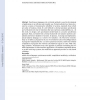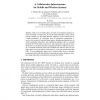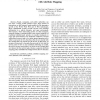65 search results - page 11 / 13 » Reconciliation of two Business Modelling Frameworks |
CORR
2008
Springer
13 years 7 months ago
2008
Springer
Synchronous languages rely on formal methods to ease the development of applications in an efficient and reusable way. Formal methods have been advocated as a means of increasing t...
EDCC
2005
Springer
14 years 1 months ago
2005
Springer
Many governmental agencies and businesses organizations use networked systems to provide a number of services. Such a service-oriented network can be implemented as an overlay on ...
NSF
2001
Springer
14 years 1 days ago
2001
Springer
Today‘s use of mobile phones is mostly for coordination purposes. It seems reasonable to assume that 3G and 4G high bandwidth systems will be used in a similar way. This paper th...
JTAER
2010
13 years 6 months ago
2010
Digital ecosystems, or IT-ecosystems (ITEs), are composed of multiple and independent entities such as individuals, organizations, services, software, and applications. Together, ...
WECWIS
2009
IEEE
14 years 2 months ago
2009
IEEE
—People, companies, and public authorities can now have a strong on-line presence and a huge amount of interactions on the Internet, made possible by the impressive growth of the...



